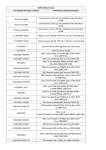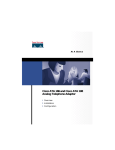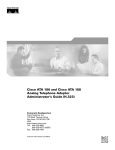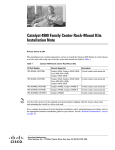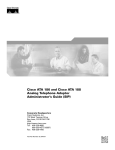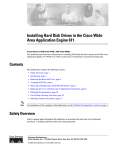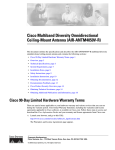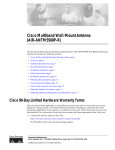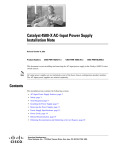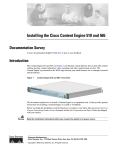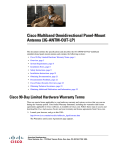Download Cisco ATA 186 and Cisco ATA 188 Analog Telephone
Transcript
At A Glance Cisco ATA 186 and Cisco ATA 188 Analog Telephone Adaptor 1 Overview 2 Installation 3 Configuration 1 Overview This guide contains basic instructions for installing, testing, and operating your Cisco Analog Telephone Adaptor (Cisco ATA 186 or Cisco ATA 188). For configuration information for use by service providers and system administrators, refer to the Cisco ATA administrator’s guide for your particular signaling image protocol (SCCP, MGCP, H.323 or SIP), available on the World Wide Web at the following location: http://www.cisco.com/univercd/cc/td/doc/product/voice/ata/ind ex.htm Figure 1 Cisco ATA Analog Telephone Adaptor CISCO A TA 186 TELEPH ONE AD APTOR 72209 ANALOG 2 Cisco ATA 186 The Cisco ATA 186 connects one or two analog telephones to an IP-based telephony network. The hardware features include: • Function button • Two RJ-11 FXS ports • RJ-45 10BASE-T uplink port • Network activity (ACT) LED • Power connector Figure 2 shows the rear panel of the Cisco ATA 186. Cisco ATA 186 Rear Panel PHONE 1 PHONE 2 RJ-11 FXS ports RJ-45 10BaseT 10BaseT ACT 72210 Figure 2 5V Power connector ACT LED 3 Cisco ATA 188 The Cisco ATA 188 connects one or two analog telephones to an IP-based telephony network. The hardware features include: • Two RJ-11 FXS ports • RJ-45 10/100BASE-T uplink port • RJ-45 10/100BASE-T data port • Two link activity (LINK) LEDs • Power connector Figure 3 shows the rear panel of the Cisco ATA 188. Cisco ATA 188 Rear Panel PHONE 1 PHONE 2 RJ-11 FXS ports LINK 10/100 PC 10/100 UPLINK LINK 5V Power connector LINK LED LINK LED RJ-45 10/100BaseT ports 4 72211 Figure 3 Safety Recommendations To ensure general safety, follow these guidelines: • Do not open or disassemble this product. • Do not get this product wet or pour liquids into this device. • Do not perform any action that creates a potential hazard to people or makes the equipment unsafe. Warning IMPORTANT SAFETY INSTRUCTIONS This warning symbol means danger. You are in a situation that could cause bodily injury. Before you work on any equipment, be aware of the hazards involved with electrical circuitry and be familiar with standard practices for preventing accidents. Use the statement number provided at the end of each warning to locate its translation in the translated safety warnings that accompanied this device. Statement 1071 SAVE THESE INSTRUCTIONS Waarschuwing BELANGRIJKE VEILIGHEIDSINSTRUCTIES Dit waarschuwingssymbool betekent gevaar. U verkeert in een situatie die lichamelijk letsel kan veroorzaken. Voordat u aan enige apparatuur gaat werken, dient u zich bewust te zijn van de bij elektrische schakelingen betrokken risico's en dient u op de hoogte te zijn van de standaard praktijken om ongelukken te 5 voorkomen. Gebruik het nummer van de verklaring onderaan de waarschuwing als u een vertaling van de waarschuwing die bij het apparaat wordt geleverd, wilt raadplegen. BEWAAR DEZE INSTRUCTIES Varoitus TÄRKEITÄ TURVALLISUUSOHJEITA Tämä varoitusmerkki merkitsee vaaraa. Tilanne voi aiheuttaa ruumiillisia vammoja. Ennen kuin käsittelet laitteistoa, huomioi sähköpiirien käsittelemiseen liittyvät riskit ja tutustu onnettomuuksien yleisiin ehkäisytapoihin. Turvallisuusvaroitusten käännökset löytyvät laitteen mukana toimitettujen käännettyjen turvallisuusvaroitusten joukosta varoitusten lopussa näkyvien lausuntonumeroiden avulla. SÄILYTÄ NÄMÄ OHJEET Attention IMPORTANTES INFORMATIONS DE SÉCURITÉ Ce symbole d'avertissement indique un danger. Vous vous trouvez dans une situation pouvant entraîner des blessures ou des dommages corporels. Avant de travailler sur un équipement, soyez conscient des dangers liés aux circuits électriques et familiarisez-vous avec les procédures couramment utilisées pour éviter les accidents. Pour prendre connaissance des traductions des avertissements figurant dans les consignes de sécurité traduites qui accompagnent cet appareil, référez-vous au numéro de l'instruction situé à la fin de chaque avertissement. CONSERVEZ CES INFORMATIONS Warnung WICHTIGE SICHERHEITSHINWEISE Dieses Warnsymbol bedeutet Gefahr. Sie befinden sich in einer Situation, die zu Verletzungen führen kann. Machen Sie sich vor der Arbeit mit Geräten mit den Gefahren elektrischer Schaltungen 6 und den üblichen Verfahren zur Vorbeugung vor Unfällen vertraut. Suchen Sie mit der am Ende jeder Warnung angegebenen Anweisungsnummer nach der jeweiligen Übersetzung in den übersetzten Sicherheitshinweisen, die zusammen mit diesem Gerät ausgeliefert wurden. BEWAHREN SIE DIESE HINWEISE GUT AUF. Avvertenza IMPORTANTI ISTRUZIONI SULLA SICUREZZA Questo simbolo di avvertenza indica un pericolo. La situazione potrebbe causare infortuni alle persone. Prima di intervenire su qualsiasi apparecchiatura, occorre essere al corrente dei pericoli relativi ai circuiti elettrici e conoscere le procedure standard per la prevenzione di incidenti. Utilizzare il numero di istruzione presente alla fine di ciascuna avvertenza per individuare le traduzioni delle avvertenze riportate in questo documento. CONSERVARE QUESTE ISTRUZIONI Advarsel VIKTIGE SIKKERHETSINSTRUKSJONER Dette advarselssymbolet betyr fare. Du er i en situasjon som kan føre til skade på person. Før du begynner å arbeide med noe av utstyret, må du være oppmerksom på farene forbundet med elektriske kretser, og kjenne til standardprosedyrer for å forhindre ulykker. Bruk nummeret i slutten av hver advarsel for å finne oversettelsen i de oversatte sikkerhetsadvarslene som fulgte med denne enheten. TA VARE PÅ DISSE INSTRUKSJONENE 7 Aviso INSTRUÇÕES IMPORTANTES DE SEGURANÇA Este símbolo de aviso significa perigo. Você está em uma situação que poderá ser causadora de lesões corporais. Antes de iniciar a utilização de qualquer equipamento, tenha conhecimento dos perigos envolvidos no manuseio de circuitos elétricos e familiarize-se com as práticas habituais de prevenção de acidentes. Utilize o número da instrução fornecido ao final de cada aviso para localizar sua tradução nos avisos de segurança traduzidos que acompanham este dispositivo. GUARDE ESTAS INSTRUÇÕES ¡Advertencia! INSTRUCCIONES IMPORTANTES DE SEGURIDAD Este símbolo de aviso indica peligro. Existe riesgo para su integridad física. Antes de manipular cualquier equipo, considere los riesgos de la corriente eléctrica y familiarícese con los procedimientos estándar de prevención de accidentes. Al final de cada advertencia encontrará el número que le ayudará a encontrar el texto traducido en el apartado de traducciones que acompaña a este dispositivo. GUARDE ESTAS INSTRUCCIONES Varning! VIKTIGA SÄKERHETSANVISNINGAR Denna varningssignal signalerar fara. Du befinner dig i en situation som kan leda till personskada. Innan du utför arbete på någon utrustning måste du vara medveten om farorna med elkretsar och känna till vanliga förfaranden för att förebygga olyckor. Använd det nummer som finns i slutet av varje varning för att hitta dess översättning i de översatta säkerhetsvarningar som medföljer denna anordning. 8 Warning Ultimate disposal of this product should be handled according to all national laws and regulations. Warning Read the installation instructions before you connect the system to its power source. Warning This equipment contains a ring signal generator (ringer), which is a source of hazardous voltage. Do not touch the RJ-11 (phone) port wires (conductors), the conductors of a cable connected to the RJ-11 port, or the associated circuit-board when the ringer is active. The ringer is activated (indicated by a clicking sound) by an incoming call. Warning The plug-socket combination must be accessible at all times because it serves as the main disconnecting device. 9 Warning To avoid electric shock, do not connect safety extra-low voltage (SELV) circuits to telephone-network voltage (TNV) circuits. LAN ports contain SELV circuits, and WAN ports contain TNV circuits. Some LAN and WAN ports both use RJ-45 connectors. Use caution when connecting cables. Warning Do not work on the system or connect or disconnect cables during periods of lightning activity. Warning This equipment is to be installed and maintained by service personnel only as defined by AS/NZS 3260 Clause 1.2.14.3 Service Personnel. Caution Read the instructions in the “Installation Steps” section on page 13 before you connect the system to its power source. 10 2 Installation Installation Requirements The analog telephone adaptor (ATA) package includes: • Cisco ATA 186 or Cisco ATA 188 Analog Telephone Adaptor • Cisco ATA 186 and Cisco ATA 188 Analog Telephone Adaptor At A Glance (this document) • Regulatory Compliance and Safety Information for the Cisco ATA 186 and Cisco ATA 188. • 5V power adaptor • Power cord Caution The Cisco ATA 186 and Cisco ATA 188 are intended for use with a 5V DC power adapter only. Use only the Cisco-approved power supply that was provided with your ATA unit. 11 You also need the following items: • Category-3 10BASE-T or 100BASE-T or better Ethernet cable. One cable is needed for each Ethernet connection. A Category-3 Ethernet cable supports 10BASE-T for up to 100 meters without quality degradation, and a Category-3 Ethernet cable supports 100BASE-T for up to 10 meters without quality degradation. For uplink connections, use a crossover Ethernet cable to connect the Cisco ATA to another Ethernet device (such as a router or PC) without using a hub. Otherwise, use straight-through Ethernet cables for both uplink and data port connections. • Access to an IP network • One or two analog Touch-Tone telephones or fax machines, or one of each 12 Installation Steps Figure 4 illustrates the cabling for the Cisco ATA 186. Figure 5 illustrates the cabling for the Cisco ATA 188. Note Before powering up the Cisco ATA, perform any necessary configuration tasks. Refer to the Cisco ATA administrator guide for your particular signaling image protocol (SCCP, MGCP, H.323 or SIP), available on the World Wide Web at the following location: http://www.cisco.com/univercd/cc/td/doc/product/voic e/ata/index.htm 13 Cabling the Cisco ATA 186 PHONE 1 PHONE 2 10BaseT ACT 72212 Figure 4 5V Power outlet IP network Analog telephones (or fax) 5V power adaptor Power cord 14 Cabling the Cisco ATA 188 PHONE 1 PHONE 2 LINK 10/100 PC 10/100 UPLINK LINK 72213 Figure 5 5V Power outlet IP network Analog telephones (or fax) PC 5V power adaptor Power cord 15 Refer to the appropriate illustration and follow these steps to install your ATA: Procedure Step 1 Place the Cisco ATA near an electrical power outlet. Step 2 Connect one end of a telephone line cord to the Phone 1 input on the rear panel of the Cisco ATA. Connect the other end to an analog telephone set. If you are connecting a telephone set that was previously connected to an active telephone line, unplug the telephone line cord from the wall jack and plug it into the Phone 1 input. Warning 16 To reduce the risk of fire, use only No. 26 AWG or larger telecommunication line cord. Do not connect the Phone input ports to a telephone wall jack. To avoid damaging the Cisco ATA or telephone wiring in the building, do not connect the Cisco ATA to the telecommunications network. Connect the Phone port to a telephone only, never to a telephone wall jack. Caution Note Step 3 (Optional) Connect the telephone line cord of a second telephone to the Phone 2 input port. Note Step 4 The telephone must be switched to tone setting (not pulse) for the Cisco ATA to operate properly. If you are connecting only one telephone to the Cisco ATA, you must use the Phone 1 input port. Connect an Ethernet cable to the uplink RJ-45 connector on the Cisco ATA. For the Cisco ATA 186, this is the 10BASE-T connector; for the Cisco ATA 188, this is the 10/100UPLINK connector. 17 Step 5 (Cisco ATA 188 only—optional) Connect a straight-through Ethernet cable from your PC to the 10/100 PC RJ-45 connector on the Cisco ATA. Step 6 Connect the socket end of the power cord to the 5V DC power adaptor. Step 7 Insert the power adaptor cable into the power connector on the Cisco ATA. Warning 18 This product relies on the building’s installation for short-circuit (overcurrent) protection. Ensure that a fuse or circuit breaker no larger than 120 VAC, 15A U.S. (240VAC, 10A international) is used on the phase conductors (all current-carrying conductors). Step 8 Connect the plug end of the 5V DC power adaptor cord into an electrical power outlet. When the Cisco ATA is properly connected and powered up, the green activity LED flashes to indicate network activity. This LED is labeled ACT on the rear panel of the Cisco ATA 186 and is labeled LINK on the rear panel of the Cisco ATA 188. Caution Do not cover or block the air vents on either the top or the bottom surface of the Cisco ATA. Overheating can cause permanent damage to the unit. Power-Down Procedure Caution If you need to power down Cisco ATA 186 or Cisco 188 at any time, use the following power-down procedure to prevent damage to the unit. 19 Procedure Step 1 Unplug the RJ45 Ethernet cable Step 2 Wait for 20 seconds. Step 3 Unplug the power cable. The unit provides the following connectors and indicators: • 5V power connector. • Two RJ-11 FXS (Foreign Exchange Station) ports—The Cisco ATA supports two independent RJ-11 telephone ports that can connect to any standard analog telephone device. Each port supports either voice calls or fax sessions, and both ports can be used simultaneously. 20 Note The Cisco ATA186-I1 and Cisco ATA188-I1 provide 600-ohm resistive impedance. The Cisco ATA186-I2 and Cisco ATA188-I2 provide 270 ohm + 750 ohm // 150-nF complex impedance. The impedance option is requested when you place your order and should match your specific application. If you are not sure of the applicable configuration, check your country or regional telephone impedance requirements. • Ethernet ports – The Cisco ATA 186 has one RJ-45 10BASE-T uplink Ethernet port to connect the Cisco ATA 186 to a 10/100BASE-T hub or another Ethernet device. – The Cisco ATA 188 has two Ethernet ports: an RJ-45 10/100BASE-T uplink port to connect the Cisco ATA 188 to a 10/100BASE-T hub or another Ethernet device and an RJ-45 10/100BASE-T data port to connect an Ethernet-capable device, such as a computer, to the network. 21 Note The Cisco ATA 188 performs auto-negotiation for duplexity and speed and is capable of 10/100 Mbps, full-duplex operation. The Cisco ATA 186 is fixed at 10 Mbps, half-duplex operation. • The Cisco ATA 188 RJ-45 LED shows network link and activity. The LED blinks twice when the Cisco ATA is first powered on, then turns off if there is no link or activity. The LED blinks to show network activity and is solid when there is a link. • The Cisco ATA 186 RJ-45 LED is solid when the Cisco ATA is powered on and blinks to show network activity. • Function button—The function button is located on the top panel of the unit (see Figure 6). 22 Figure 6 Cisco ATA Function Button Function button CISCO 72214 ATA 186 ANALOG TELEPH ONE AD APTOR The function button lights when you pick up the handset of a telephone attached to the Cisco ATA. The button blinks quickly when the Cisco ATA is upgrading its configuration. Note If the function button blinks slowly, the Cisco ATA cannot find the DHCP server. Check your Ethernet connections and make sure the DHCP server is available. 23 Pressing the function button allows you to access to the voice configuration menu. For additional information about the voice configuration menu, see the information about the voice configuration menu in your administrator’s guide. Caution 3 Never press the function button during an upgrade process. Doing so may interfere with the process and may permanently disable the Cisco ATA. Configuration For complete configuration information, see the administrator’s guide for the signaling image protocol you are using (SCCP, MGCP, H.323 or SIP). The Cisco ATA administrator’s guides are located at the following URL: http://www.cisco.com/univercd/cc/td/doc/product/voice/ata/ata admn/index.htm 24 Making a Call Lift the telephone handset. Make a call as you normally do. You will hear ringing if the called party is available. When the called party answers, speak normally and hang up when finished. You can cancel or discontinue your call at any time by hanging up the handset. You can make a separate, simultaneous telephone call by using the second handset connected to the ATA. Note Your service provider or system administrator might offer a different dial plan. If you cannot place calls using the preceding instructions, contact your service provider or system administrator for assistance. Troubleshooting Tips The suggestions in this section are general troubleshooting tips. • Make sure that the DHCP server is operating correctly. Note that the function button blinks slowly when the Cisco ATA attempts to acquire the DHCP configuration. • If the green activity LED is not flashing after you connect the Ethernet cable, make sure that both the power cord and the Ethernet connection are secure. 25 • If there is no dial tone, make sure that the telephone line cord from the telephone is plugged into the appropriate port on the Cisco ATA. Make sure that your Cisco ATA is properly registered on your Call Control system. Test another phone; if this phone does not work either, there may be a problem with the current configuration or with the Cisco ATA. • A busy tone indicates that the party you called is not available. Try your call again later. A fast-busy tone indicates that you dialed an invalid number. • After power up, if the function button continues to blink slowly, the Cisco ATA cannot locate the DHCP server. Check the Ethernet connection and the availability of the DHCP server. • The DHCP server should show an incoming request from the MAC address listed on the product label or given by the voice prompt. Note 26 Customers who obtained their equipment through service providers, independent dealers and other third parties must contact their equipment provider for technical assistance. 27 CCVP, the Cisco logo, and the Cisco Square Bridge logo are trademarks of Cisco Systems, Inc.; Changing the Way We Work, Live, Play, and Learn is a service mark of Cisco Systems, Inc.; and Access Registrar, Aironet, BPX, Catalyst, CCDA, CCDP, CCIE, CCIP, CCNA, CCNP, CCSP, Cisco, the Cisco Certified Internetwork Expert logo, Cisco IOS, Cisco Press, Cisco Systems, Cisco Systems Capital, the Cisco Systems logo, Cisco Unity, Enterprise/Solver, EtherChannel, EtherFast, EtherSwitch, Fast Step, Follow Me Browsing, FormShare, GigaDrive, HomeLink, Internet Quotient, IOS, iPhone, IP/TV, iQ Expertise, the iQ logo, iQ Net Readiness Scorecard, iQuick Study, LightStream, Linksys, MeetingPlace, MGX, Networking Academy, Network Registrar, PIX, ProConnect, ScriptShare, SMARTnet, StackWise, The Fastest Way to Increase Your Internet Quotient, and TransPath are registered trademarks of Cisco Systems, Inc. and/or its affiliates in the United States and certain other countries. All other trademarks mentioned in this document or Website are the property of their respective owners. The use of the word partner does not imply a partnership relationship between Cisco and any other company. (0709R) Printed in the USA on recycled paper containing 10% postconsumer waste. 78-15931-01




























